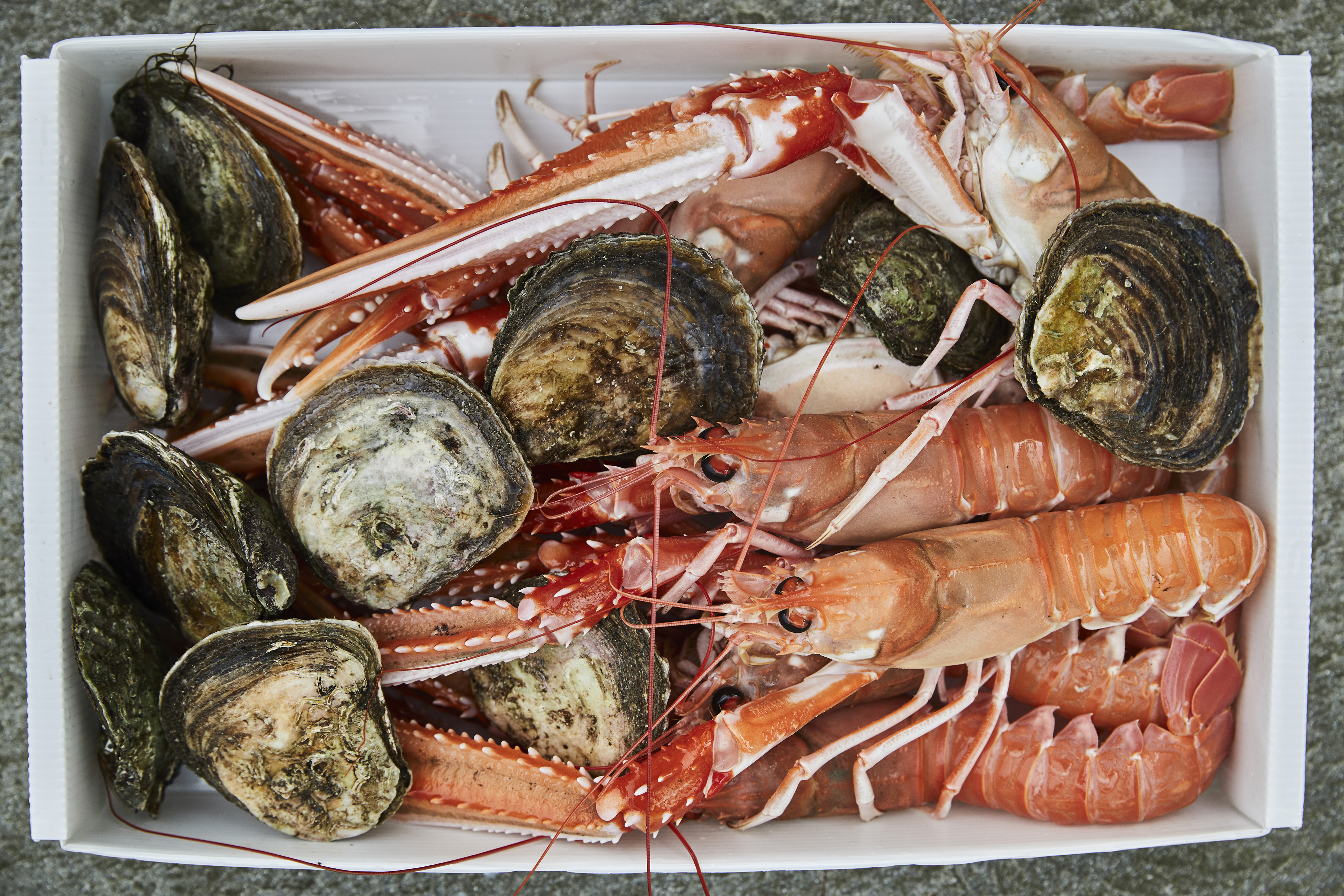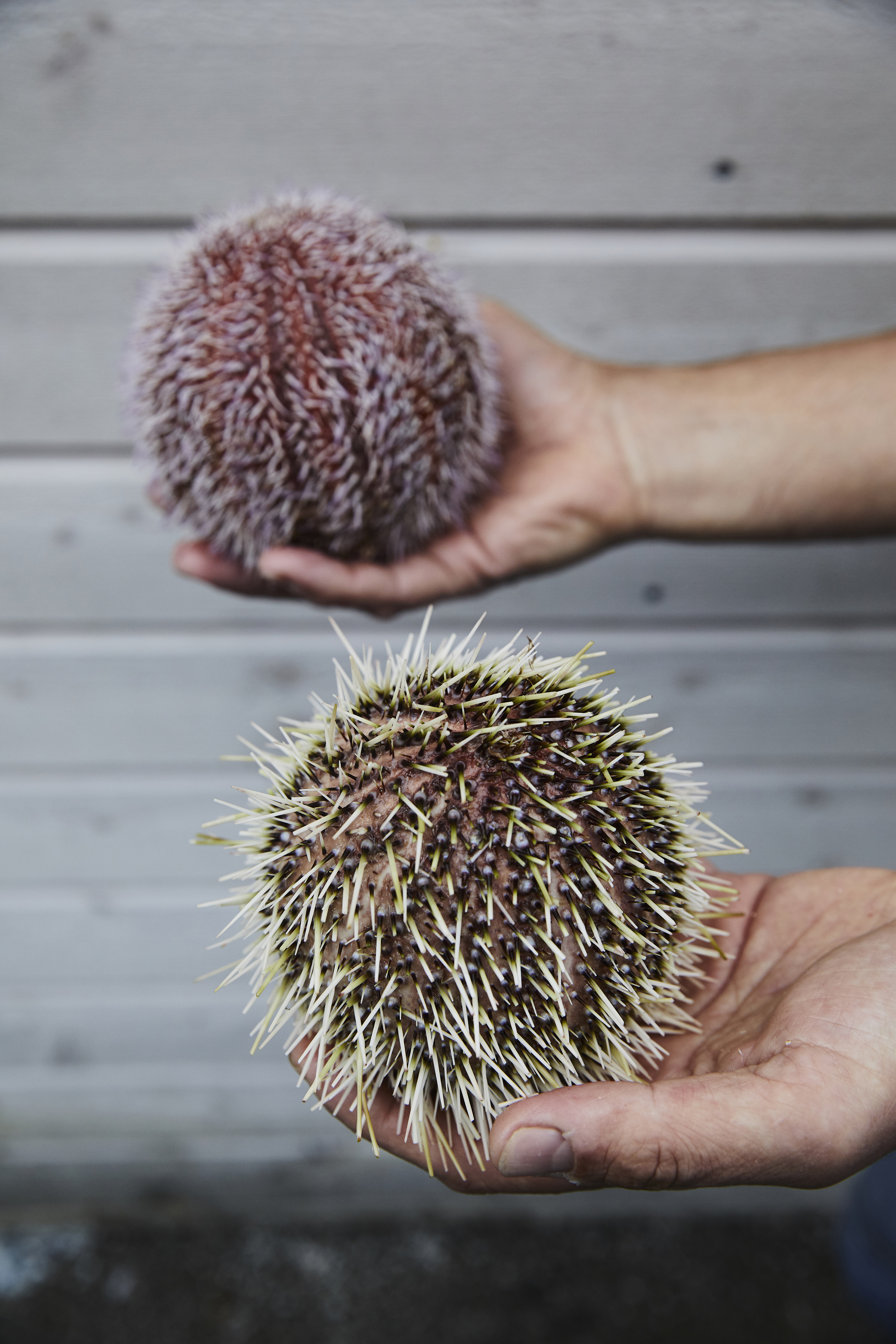North of Nordic: A Young Chef Invents ‘Neo-Fjordic’ Cuisine
BERGEN, Norway — “So this little ball of depressing represents the past of Norwegian food,” said chef Christopher Haatuft as he lovingly set down a drab bite of smoked mackerel butter on rye-pumpernickel bread.
“This one is the future, the way it should be,” he said, pointing to a snowy pile of sugar-and-salt-cured halibut, garnished with horseradish shavings and baby alfalfa.
“And this last one is just for fun,” he added, a tiny Scandinavian “shawarma” of potato flatbread wrapped around pickled herring. It’s a nod to the late-night street food Haatuft, 37, knew when he was a teenager here, thrashing around in the punk scene — and a joke about Norway’s inexorable, traditional diet of potatoes and herring.
In three bites at Lysverket, Haatuft’s restaurant here, he conveys everything he wants the food of Norway to be: nostalgic, sustainable, creative, delicious and witty. He’s a Bergen native, but his mother is American. Dual citizenship allowed him to spend two years in ambitious kitchens in the United States, like the ones at Per Se, Alinea and Blue Hill at Stone Barns, after he completed culinary training in Europe.
When he returned to Bergen in 2012 to open his own place, he first had to figure out his relationship with New Nordic cuisine — an inescapable label for modern Scandinavian chefs. Its commitment to local, pure and beautiful food has proved to be more than a trend: It is a durable international movement, led by chefs like René Redzepi of Noma and Christian Puglisi of Relae in Copenhagen, Gunnar Gislason of Agern in New York and Esben Holmboe Bang of Maaemo in Oslo (the only restaurant in Norway to earn three Michelin stars).

Many of the New Nordic chefs are guided by solemn manifestoes about nature and culture. They often restrict themselves to Scandinavian ingredients, eliminating tomatoes, olive oil and peaches in favor of elderflower, sea buckthorn and pine needles. (The last, Haatuft said, is part of “the eternal Nordic quest for acid that isn’t lemon.”)
Since he is the opposite of solemn, he coined a new term for the food at Lysverket: neo-fjordic.
“At first it was a joke,” he said. “But the fjords are what make Norway different, and that’s what I want my food to be.”
Many things are different about Norway’s geography, most of which make Haatuft’s work more difficult. Compared with Bergen’s rugged terroir, the area around Copenhagen, the birthplace of New Nordic, is as bright and balmy as the South of France. Here, rain falls more than 230 days a year, only about 3 percent of the land is arable and the winter is so long that it is divided into two parts. (Morketid, the “dark time,” starts in October and lasts until January’s Soldagen, “sun day,” when the sun reappears but the weather grows colder.) Denmark has more sun, a longer summer and land that is flat and fertile enough for farming.
Because of these harsh conditions, restricted land ownership and the frigid isolation of many rural areas, preindustrial Norway was singularly inhospitable to the small farmers who made up most of the population. In the late 19th century, hundreds of thousands of Norwegians — eventually, a third of the entire population — began leaving for the United States.
“The big question for Norwegian farmers was not which kind of apples to grow, but how to not starve to death,” Haatuft said. Deliciousness, he said, was a luxury they could not always afford.
“As recently as my grandmother’s time, people used cod liver oil as a cooking fat when there was nothing else,” he said. “You could smell it for days.”
That is one tradition he is not interested in bringing back.

Instead of foraging in the past for inspiration, Haatuft asked himself a hypothetical question: “If western Norway were a region of France, what would the chefs here brag about?”
His theory is that the prestigious classic cuisine of France is “farm food that was beautified and refined” to suit the tastes and whims of rich people. In Norway, he said, there was never enough wealth to transform food into cuisine. (That changed after oil production began in the North Sea in the 1970s, making modern Norway one of the world’s wealthiest nations.)
Traditional Norwegian food is famously bland, with infinite recombinations of fish, potatoes, flour and milk. But those porridges and dumplings were often spiked with intense tastes like smoked lamb and reindeer, salt-fermented salmon, goat salami and pickled root vegetables. The country has top-quality dairy products, berries that grow sweet in the 18-hour days of summer and complex aged cheeses. Extraordinary fresh seafood is harvested from the cold waters of the North Atlantic and the North Sea, and preserved using time-honored traditions that are just as complex as French charcuterie.
“A French chef here would brag about the smoked mackerel,” he said. “He would clean out the dark parts to make it beautiful. He would add butter to make it rich and smooth, and make the flavor of the ingredient shine.”
That is precisely what Haatuft does at Lysverket.
Fiskesuppe, a traditional Bergen fish chowder, was traditionally thickened with flour. In modern times, cooks have added egg yolks and sour cream to enrich the broth. But to lift the flavors, Haatuft adds a bright green drizzle of leek oil, and diced carrots and celeriac pickled in distilled vinegar. “That’s what the grandmothers used,” he said. “Why should I use wine vinegar?”
One dessert at Lysverket is an ethereal cake made with almonds, chocolate and gjetost, the caramelized, spreadable goat cheese that resembles Latin American dulce de leche and is a national obsession.
To procure the ingredients he needs, Haatuft spends much of his time on projects like nabbing loads of fresh herring before they are sent to the central market (Norwegian fishermen are not allowed to sell directly to chefs), tracking down divers and hounding the region’s farmers to grow more diverse crops.
To ensure a steady supply of flavorful, fatty pork, he prodded his friend Anders Tveite, a chef turned farmer, to start raising Mangalitsa pigs, whose woolly coats allow them to live outside all year, even in these rough mountains, still snowcapped in early July. In advance, Haatuft promised to buy all the meat that the farm wanted to sell him.

“There just isn’t enough good produce to go around,” he said, crawling up steep strawberry beds at a farm in the mountainous Voss region northeast of Bergen. “It’s not like being at Per Se, where there are seven other farmers I can go to for organic produce if my guy doesn’t have what I need. This is it.”
Although the movement toward local, sustainable and traditional food is relatively new here — frozen pizza is the unofficial national dish, particularly the beloved cult brand Grandiosa — it is growing quickly. In addition to offering generous farm subsidies, the government now funds agricultural education, food startups and gastrotourism by aggressively marketing Norway’s seafood, its pristine terroir and its many accomplished chefs.
Tone Ronning Vike, a former journalist, recently moved her family from Bergen to run a centuries-old family dairy farm along the Aurland River with the help of a government grant. For the farm’s guesthouse, she buys potatoes from Norway’s only school of organic agriculture, goat cheese from the two remaining local farmers who produce it, and reindeer meat and mountain trout from Sami hunters and fishermen. (The Sami are modern descendants of the ancient people of Arctic Europe, and the only people in Scandinavia who are permitted to herd reindeer.)
“Norwegians already have a healthy lifestyle; we hike, we hunt, we ski,” she said. “But there’s still a lot of room for education about how to eat well.”

Vike, like Haatuft and virtually everyone involved in bringing better food to Norway, is concerned about how the country’s booming aquaculture industry fits in. Neither of them serves the globally popular product labeled “Norwegian salmon,” knowing that it is not wild, but farmed in the country’s waters.
Norway is the second-largest exporter of fish in the world, and seafood is the country’s second-most-valuable export after oil. Seventy percent of that export value is in farmed salmon, an increasingly controversial product. Even with modern technology and strict regulation, penned fish have mixed with the wild population, introducing catastrophic parasites like salmon lice. Pesticides, food waste and sewage have seeped into fjords and rivers. Millions of farmed fish have escaped into inland rivers, upsetting the ecosystem of spawning.
Many restaurants do serve farmed salmon, and both the systems and the regulations for aquaculture are getting tighter. “Norway is working strongly toward a sustainable aquaculture industry,” said Silje Lesjo, a specialist in local food for Innovation Norway, a government agency that provides support for high-tech businesses. Advanced aquaculture technology has also become a valuable Norwegian export.
The halibut served at Lysverket is farmed in one of these innovative systems — in pens built on land, a more difficult and expensive method, but one that does not affect the water or wild fish. And Haatuft works only with fishermen who pull in wild creatures like cusk, sea urchins, langoustines and mahogany clams — big specimens with thick brown shells that live for up to 400 years.
In a storage shed in Sotra, an island just off the Atlantic coast, surrounded by tubs of live seafood, Haatuft opened a salad-plate-size scallop, pulling aside the mantle and the roe to get to the plump meat. Slicing it up in the shell with his pocketknife, he relished the squirm and the salt water that made the flesh taste fully alive.
A few hours later at the restaurant, he grilled the scallops on just one side to firm up the muscle, then set off their sweetness with baby radishes and a bright, pleasingly bitter purée of nasturtium leaves. (Nasturtiums, like dill, sorrel, ransom, lovage and other pungent herbs, thrive in Nordic climates.)
One commodity in short supply in Bergen is sous-chefs, but Haatuft is not planning an active recruitment effort.
“Why would I encourage people to take a hard, hot job working 16 hours a day, when in Norway they could work seven hours in an office and still get free health care?” he said.
“I want the people who can’t do anything but cook, people whose only dream in life is to be a chef. People like me.”






